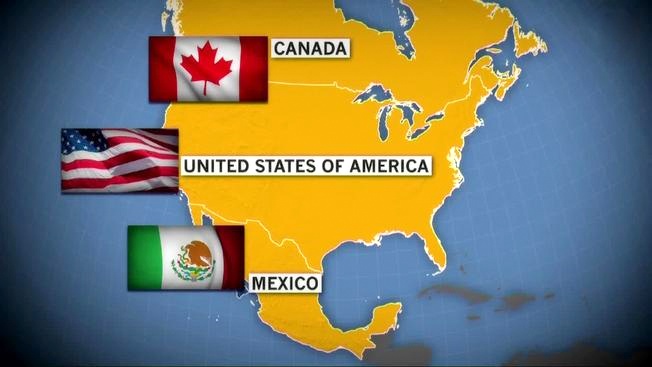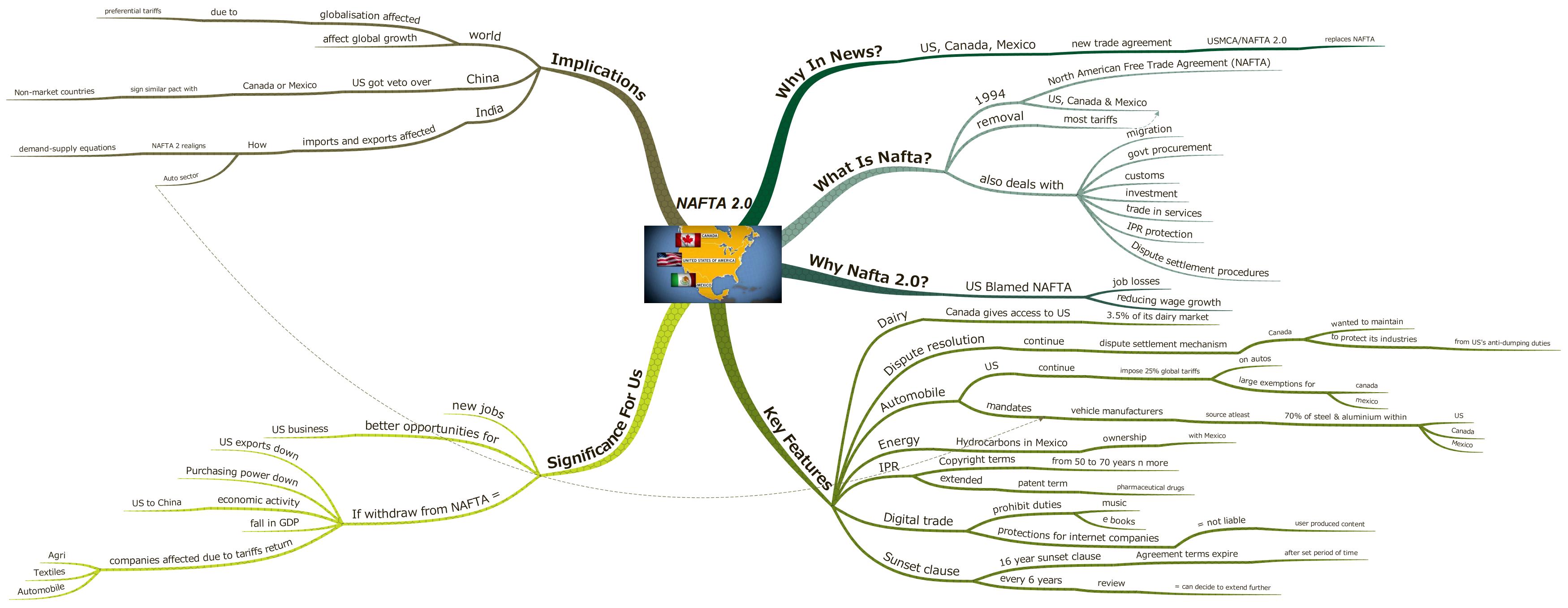NAFTA 2.0 (USMCA) – Everything You Need to Know

From Current Affairs Notes for UPSC » Editorials & In-depths » This topic
IAS EXPRESS Vs UPSC Prelims 2024: 80+ questions reflected
On September 30, 2018, the US, Canada, and Mexico signed a new trade agreement to replace the old North American Free Trade Agreement (NAFTA). The new deal is named as United States-Mexico-Canada Agreement (USMCA) or popularly, NAFTA 2.0. The 3 countries reached the deal after more than a year of discussions, which began after President Trump promised in his election campaign to renegotiate the 25-year-old agreement.
What is NAFTA?
- The US had originally signed a bilateral trade agreement with Canada named, US-Canada Free Trade Agreement, which was brought in to force in 1989.
- Later, Mexico joined the deal, resulting in the North American Free Trade Agreement (NAFTA), which was enforced from 1994.
- NAFTA led to the removal of most of the tariffs between these three countries.
- NAFTA also deals with migration, government procurement, customs procedures, investment, trade in services, protection of intellectual property rights and dispute settlement procedures.
Why US wants new NAFTA?
- In May 2017, US Trade Representative declared that the US seeks to start negotiations with Canada and Mexico with regards to the NAFTA. And Mr. Trump also promised in his election campaign to renegotiate the 25-year-old agreement.
- Since its introduction, the NAFTA has been blamed for job losses in traditionally heavy manufacturing states like Michigan and for reducing wage growth in the US.
- Therefore, the renegotiation was meant to facilitate higher-paying jobs in the US and to improve the terms of trade that the US had with Canada and Mexico.
Also read: COMCASA: The Pact that will boost India’s Defence Capability
What are the key features of NAFTA 2.0?
- Dairy: Canada agreed to provide US dairy farmers access to about 3.5% of its annual domestic dairy market. Canada also agreed to offer compensation to US dairy farmers hurt by the NAFTA.
- Dispute resolution: The deal will continue a trade dispute settlement mechanism that Canada fought hard to maintain in order to protect its lumber industry and other sectors from U.S. anti-dumping duties.
- Automobile: The US preserve the ability to impose 25% global tariffs on autos while largely exempting passenger vehicles, pickup trucks and auto parts from Canada and Mexico. The pact also mandates that vehicle manufacturers source at least 70% of their steel and aluminium from within the three countries.
- Energy: The deal states that Mexico has the direct and inalienable ownership of all hydrocarbons in the country. This reflects the concerns of Mexico’s incoming government that the deal would restrict the country’s control over its oil resources. However, it does not prevent foreign oil companies from producing oil in Mexico under a liberalization regime imposed by the outgoing government.
- Intellectual property: The deal extends the terms of copyright to 70 years beyond the life of the author (from the current 50). It also extends the period that a pharmaceutical drug can be protected from generic competition.
- Digital trade: It also has provisions to deal with the digital economy including prohibiting duties on products like music and e-books, and protections for internet companies so that they are not liable for content produced by their users.
- Sunset clause: The agreement includes a 16-year sunset clause, which means that the terms of the agreement expire after a set period of time. The deal is also subject to a review every 6 years, at which point the three countries can decide to extend the deal further.
What is the significance of NAFTA 2.0 for the US?
- Many experts believe that re-negotiating the NAFTA is most likely to result in the creation of new jobs or better opportunities for US businesses.
- If America withdraws from NAFTA due to unfavorable terms, it would lead to the reduction of global exports of the US by 2.5%, reduce the purchasing power of American households due to higher prices and shift economic activity away from the US towards China. This will result in the fall of the GDP growth rate by 0.2%. Agriculture, textiles and automobile companies in the US will also be affected due to the return of tariffs.
Also read: China Pakistan Economic Corridor (CPEC) – Why Pakistan invited Saudi Arabia?
What are the implications for the world and India?
- Re-negotiating trade pacts that have promoted globalization over the last 50 years is a serious concern. Because if each country attempts to protect its businesses and adopts a tariff structure accordingly, then there will be chaos since countries with the exportable surplus will resort to dumping their products in other markets. This will affect global growth in the long run.
- It could become a major threat to China because it gives a near veto-power to the US over any attempt by Canada or Mexico to try to reach a similar agreement with countries of non-market economy status which China is yet to acquire.
- Indian imports and exports will be affected because the new deal re-aligns the demand-supply equations in several commodities.
- The biggest impact is going to be in the auto section that stipulates conditions such as manufacturing a greater portion of vehicles in the three countries and with high-wage labour in the US and China.
Practice Questions
- Discuss the key features of NAFTA 2.0 / USMCA and examine its implications for the world and India.
If you like this post, please share your feedback in the comments section below so that we will upload more posts like this.


